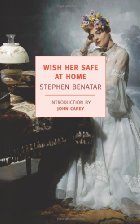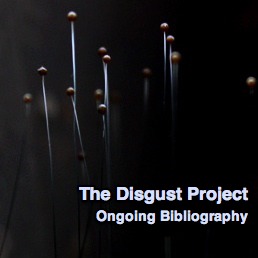
Stephen Benatar's Wish Her Safe at Home is the most laugh-out-loud fun I've had with a book in a long time. Even if the laughs were accompanied by cringes; even if the fun was the kind that you can get peeking out from between the fingers you're holding up in front of your eyes; and even if I kept groaning and wincing as I compulsively turned the pages, the fact remains that I could hardly tear myself away from Benatar and his perilously deluded but always optimistic heroine, Rachel Waring.
Wish Her Safe at Home is the unreliable-narrator novel par excellence. We realize right away that Rachel is a bit off. It only takes a few more pages to realize that she is refashioning what we might call neutral reality into a universe that revolves around Rachel herself—a place where strangers in tea shops are fascinated to learn about her rocky relationship with her mother; a place where sermons are preached to her alone, and a chemist's banal chit-chat is a veiled promise of love and romance; a place of songs, dances, and encounters with new friends who are uniformly impressed with her singing voice, her fashion sense, and her elliptical, coded references to popular culture. Here she is, for example, at the christening of a friend's baby:
But then of course there were his friends, his and Celia's—I musn't lump them in with the rest—although surprisingly they weren't quite so easy to distinguish as I'd assumed that they were going to be.
"Friend or foe?" I asked a tall and rather handsome young man whom I considered to be one of the likelier contenders. "In place of a Masonic handshake," I genially explained.
"Excuse me?"
"I mean, friend or...?" "Family," I had nearly said. Luckily at the eleventh hour I remembered my diplomacy. "Well, let me propound it to you in another way: if this were an invasion of the body snatchers would you be one of the bodies or one of the snatchers?" I laid my hand on his sleeve. At parties—well, especially at parties—it was always one's duty to be as entertaining as one could. "Of course, it does occur to me I'll have to examine your answer very carefully! For would a snatcher admit to being a snatcher? Wouldn't he try instead to palm himself off as a body?"
A lot of what distinguishes Rachel's voice can be seen here: her tendency to treat strangers she's just met as if they were in on some coded joke; Benatar's hilarious use of adjectives and adverbs ("I genially explained") to play up the difference between Rachel's perceptions and those of the people around her. In another great example of this, Rachel claims that she "executed a few unobtrusive dance steps" while waiting in line at the pharmacy. Do the people around her think her explanations genial or her dance steps unobtrusive? Does it matter?
Indeed, one of the most winning things about Benatar's book is that, despite careening ever more quickly along the slippery slope to utter mania, Rachel is hard not to like. Even though I am aware, while reading, that her version of events may not be "accurate," there is a part of me that prefers her sunny, magical version of the world to the one in which strangers in tea shops don't give a damn about one's mother, and banal shop chatter is just a way to fill the empty minutes. In her own mind, Rachel is some kind of mash-up of Scarlett O'Hara, Cinderella, and Gypsy Rose Lee, and spending time in her world is often a lot of fun, even if it's also intensely awkward when the reader is caught between his own perception (Rachel is acting radically inappropriate), and Rachel's perception (that she is acting like a gracious lady of the Georgian aristocracy/antebellum South/Broadway stage).
And in fact, Broadway musicals, along with Gone with the Wind, Pride and Prejudice, and occasionally a Tennessee Williams play, seem to make up the entirety of Rachel's cultural universe. When she trips through town with a song on her lips (which is often), and despite the book being set in 1981, that song is generally by Harry Warren, Jerome Kern, Noël Coward, Bing Crosby, or similar. As a childhood lover of Broadway musicals this was great fun for me personally, but it did give the novel a strange, unseated feeling: except for a mention of the royal wedding between Prince Charles and Diana, these events could have been taking place any time after the Second World War. This contributes to the feeling that Rachel is floating in her own mental stew, unmoored from any contact with the solidity of the present day.
It also made me wonder, at times, whether and to what extent Rachel should be read as a coded gay man. I certainly don't want to imply that gay men are the only lovers of the Broadway stage; far from it. But it is a genre often associated with the gay theater culture, and many of the great song- and book-writers have been gay or bisexual. Tennessee Williams, too, was a gay playwright who addressed themes of sexuality in many of his works, and Rachel identifies herself with his character Blanche DuBois. Blanche, like Rachel, descends into madness—in Blanche's case, after precipitating her husband's suicide by telling him that his homosexuality disgusts her. In telling her own story, is Rachel also trying to disguise male homosexuality by casting herself/himself as a straight woman? She does, throughout the novel, construct her own femininity in more and more outrageous ways, eventually reaching a point where she goes around perpetually clad in a wedding dress like a chipper, showtune-singing Miss Havisham. By this point she's definitely in drag, whether or not she is biologically female. So too, much of her lust for the young gardener and law student Roger, which on the surface is inappropriate because of their age difference and contractor/client relationship, mirrors the longing of a gay man for a straight man:
He was nicely tanned and muscular and worked without his shirt and though I kept being drawn towards the window of my bedroom I found him almost unbearable to watch; in particular the way he swung his pick when breaking up the concrete. And when I went to speak to him, to settle some fresh point or take him out a cooling drink, I was really afraid of what my hands might do. Fly up to feel the film of moisture on his chest? Fondle that coat of darkly golden hair? Dear Lord! The embarrassment! Whatever would one say? "Whoops! Please forgive me! I thought there was a fly." It was like experiencing a compulsion to punch a baby's stomach in the pram, or to use on someone standing next to you the carving knife you held.
He was only twenty-one.
But despite such unsettling irrelevancies I felt blest to have him there: somebody straight and vigorous and clean who might one day achieve eminence and who would certainly love widely and be widely loved, spin a web of mutual enrichment from the threads of many disparate existences: a beguiling web whose silken strands must soon make way for even me.
Is it coincidental that Rachel describes Roger, admiringly, as "straight" while thinking about how widely he will be loved? Would any of this have occurred to me had I not known that Benatar himself is gay?
I'm not sure if this reading is wildly off-base, but then again, Rachel herself is so out of touch with the divide between imagination and reality, that the reader is often unclear on which of the events she reports are actually true and which imagined. Given her obsession with the tropes of popular romance, it's especially hard not to look askance at events that might fit into those tropes. Even her inheritance of her great-aunt's Georgian mansion, which happens in the first few pages and precipitates the entire plot of the book, looks suspiciously novelistic—and yet, scenes that follow seem uncomfortably real. Similarly, Rachel tells a story of going to a party and wowing all the guests with her virtuosity at reciting Alfred Lord Tennyson's "The Lady of Shalott." It seems very unlikely that the party guests actually reacted as she reports, and yet a whole series of real-seeming events, some of them unflattering to Rachel, result from said reactions. Should we conclude that the entire string of events is imaginary? Or that the events happened, but the other people involved had different motivations from the ones Rachel assigns? Benatar does an excellent job of blurring the line between real and imagined, while at the same time making Rachel's descent into madness abundantly clear. And even as she disintegrates, I find myself hoping for the best for Rachel. I so enjoyed the time we spent together.

Wish Her Safe at Home was my fifth book for the Challenge that Dare Not Speak Its Name, and this review is my last-minute contribution to the NYRB Reading Week festivities. Thanks to Honey and Mrs. B for hosting!

